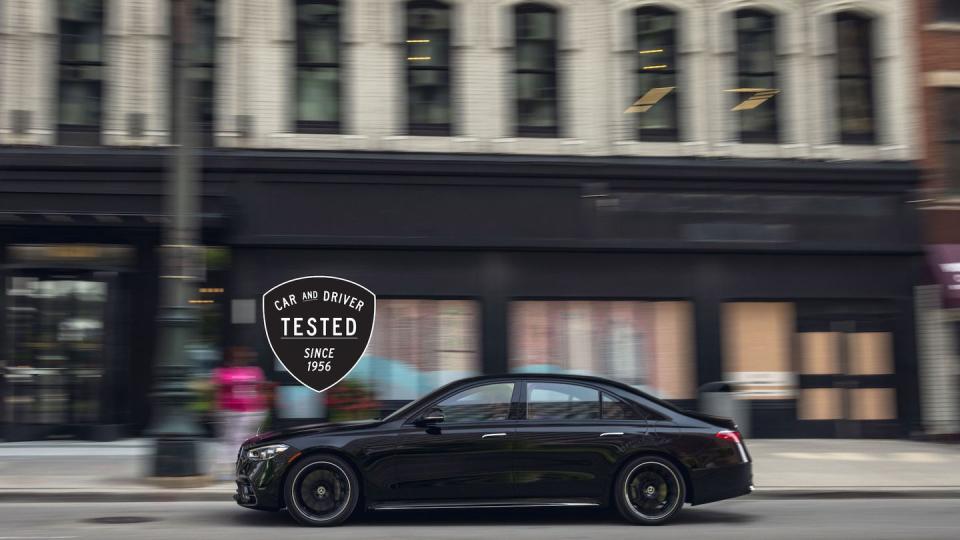2023 Mercedes-Benz S580e PHEV Sets Record in Our Electric Range Test

The 2023 Mercedes-Benz S580e has the longest electric range of any plug-in hybrid we've tested on our 75-mph real-world route.
The $120,000-plus sedan went 58 miles in EV mode, exceeding its estimated EPA range by 12 miles and beating the next-closest PHEV by 14 miles.
The plug-in S-class's sizable 22.7-kWh battery is primarily responsible for its notable test result.
Welcome to Car and Driver's Testing Hub, where we zoom in on the test numbers. We've been pushing vehicles to their limits since 1956 to provide objective data to bolster our subjective impressions (you can see how we test here).
Plug-in hybrids have an advantage over electric vehicles: When their batteries run dry, their internal-combustion engines can complete the rest of the journey. However, for folks who want a PHEV with more than 40 miles of electric-only range, there are just a handful to choose from, and the new-for-2023 Mercedes-Benz S580e is one of them. It also recorded the longest real-world electric range of any plug-in hybrid we've ever tested on our 75-mph highway route.
Going the Distance
The EPA estimates the plug-in S-class can go 46 miles on electricity alone. In our testing, the six-figure sedan beat that bogey by 12 miles, traveling 58 miles in EV mode. That's 14 miles more than any other PHEV we've tested. Second place goes to the 2024 Volvo V60 Polestar Engineered, which made it 44 miles (three more than advertised). The only other plug-in we've seen crack the 40-mile mark was a 2018 Honda Clarity that went 41 miles—and we've now evaluated over 45 PHEVs since this test first began back in 2016.

For context about how we achieved these results, allow us to explain our procedure. All tests are run at a GPS-verified 75 mph on the same 200-mile out-and-back loop on our Ann Arbor, Michigan–area highways. We're meticulous about this process, which includes using cruise control and setting the automatic climate control to 72 degrees. Plug-in hybrids require extra steps where we make sure the battery is fully charged before beginning the route and then recording the kilowatt-hours (kWh) needed to fill the battery after completing the loop. The PHEV's highway EV range is recorded when the battery is depleted and the gas engine takes over.
A Big Battery Helps
So, what's the magic behind the S580e's record-setting real-world range? Sure, its long and low body has a slippery 0.22 drag coefficient according to Mercedes, but our test car's Hankook Ventus S1 Noble 2 all-season tires are decently grippy (0.85 g on the skidpad), and we wonder if a set of low-rolling-resistance rubber might aid efficiency even further. The key enabler to the big sedan's notable range is its big battery.

Holding 22.7 kWh of energy, the Mercedes's battery is 52 percent larger than the Volvo V60's 14.9-kWh pack. Obviously, the plug-in S-class didn't travel 52 percent farther in our test; its efficiency was further compromised by its hefty 5606-pound curb weight (1112 pounds more than the V60). Still, the S580e is the first PHEV to surpass the 50-mile milestone—let alone almost reach 60—in our real-world electric-range test. And it didn't do so bad after its battery was depleted, either, averaging 36 mpg when running primarily on its 362-hp turbocharged inline-six for the rest of the loop, again beating its EPA label value of 29-mpg highway by a sizable amount.
That the plug-in S-class is still plenty posh and, with its 510 combined horsepower, keeps pace with the V-8-powered S580, leaping to 60 mph in 4.2 seconds and through the quarter-mile in 12.6 seconds, makes these efficiency results especially worthy of recognition.
You Might Also Like

 Yahoo Autos
Yahoo Autos 